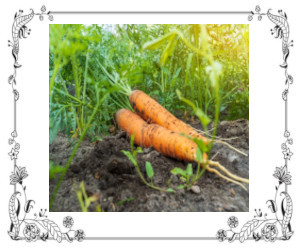Gardening Tip of the Day
Carrots are an easy vegetable to grow. Here are some tips to growing carrots successfully.
There are many varieties of carrots to choose from including short to long, thin to stubby. Various colors are available from traditional orange to red and purple.
Carrots should be planted after danger of frost is over in the spring. If a fall crop is desired it should be planted in August.
Carrots need loose soil so the beds need to be dug 8 to 12 inches deep. Add plenty of compost and mix well. This also promotes good drainage. Hard soil and rocks will cause misshapen carrots.
Plant seeds one-fourth to one-half inch deep in rows 12 to 18 inches apart. Keep soil moist. After seeds sprout thin plants to about 3 inches apart so the roots can develop without crowding. For a continuous crop of carrots all summer carrots can be planted every two to three weeks.
Carrot seed is very tiny. A lot of gardeners find that planting seed tape is much easier. Just lay the seed tape in the furrow and cover with soil.
Carrots need more potassium and phosphorus than nitrogen. Nitrogen will promote top growth but the roots need phosphorus.
Mulch carrots to prevent weeds. The mulch will also keep the soil moist. Carrots should receive one inch of water per week. Overwatering carrots can cause carrots to crack.
The main pest of the carrot is the rust fly. There are two generations of rust fly. The best way to prevent the carrot rust fly is to plant after the first week of June and harvest before the first week of September. To prevent rust fly without chemicals some gardeners plant onion or garlic in the carrot beds. Floating row covers are also excellent. Never plant carrots in the same bed every year.
Carrots may be harvested at any stage when they reach about the size of a finger; but for winter storage allow carrots to grow to full maturity. They will be sweeter and last longer. After harvesting wash any soil off and let them dry thoroughly before storing. After they are dry cut the leafy growth off to one inch of the carrot root.
Fresh carrots should be stored in a cool basement or cellar. The temperature should be just above freezing. Layer them having peat moss, sand, straw, newspapers, or other dry material keeping them apart. Carrots can also be canned or frozen.
Carrots can also be left in the garden if well covered with straw, leaves, or mulch to keep the soil from freezing.
For more tips on growing carrots successfully:
Carrots Companion Plants
Quick and Easy Pickled Carrots
Click here for a great assortment of carrot growing supplies at Amazon.
Author Marilyn Pokorney
Copyright Marilyn Pokorney 2025




